20090630
Brittany's Lighthouses in FS2004
20090629
Northern Lighthouses
Film of my trip today to the Lighthouses of the most Northern and Northeasterly points of the mainland UK:
Dunnet Head, Nr Thurso, Duncansby Head Nr John O Groats with views of Muckle Skerry ( Pentland Skerries) and Stroma Island Lighthouses.

The Light Of Life
The Light Of Life, another work featuring lighthouses to convey that Jesus is our Life Light. He will guide us with His unfailing love and grant us eternal life in Him.
music: Anywhere is by Enya, The Memory Of Trees CD by Reprise
20090627
Split Rock Lighthouse
 Coordinates WGS-84 (GPS) 47.20005°N -91.3669°E
Coordinates WGS-84 (GPS) 47.20005°N -91.3669°E
 Split Rock Lighthouse was built in 1910 in Two Harbors, Minnesota on Lake Superior. It was accessible only by water until 1924 when the North Shore highway was built. The lighthouse closed in 1969, but has been meticulously restored to its pre-1924 appearance and is currently a popular tourist attraction.
Split Rock Lighthouse was built in 1910 in Two Harbors, Minnesota on Lake Superior. It was accessible only by water until 1924 when the North Shore highway was built. The lighthouse closed in 1969, but has been meticulously restored to its pre-1924 appearance and is currently a popular tourist attraction.Stamp Information
This stamp was issued by the United States Postal Service on June 17, 1995 as part of the Great Lakes Lighthouses Issue series.
 |
|

3713 Split Rock Lighthouse Rd.
Two Harbors, MN 55616
(218) 226-6372
20090626
Lighthouse Point, Santa Cruz
Point Santa Cruz Lighthouse
The current working brick lighthouse was erected as a memorial to Mark Abbott, a surfer who drowned nearby in 1965. The lighthouse was built by his parents in 1967, and houses a surfing museum. The lantern room is from the 1903 Oakland Harbor Lighthouse.
The original lighthouse was erected on Point Santa Cruz in 1869. In 1878, the lighthouse was moved inland about 300 feet due to gradual erosion of caves underneath the point. During the 1940's the lighthouse was replaced by an automated wooden tower and the original structure was razed for salvage.


Location: Santa Cruz, CA
Photographer: Ron Karpel
Email: ronny@karpel.org
Phone: 415-987-5109
Date: December 7, 2003
ID: 20040229_02
20090624
From East to West; New Brighton, The Wirral
There was a Kite Festival on Saturday at New Brighton, so we went with the in-laws to The Wirral to see what was going on.
A throughly enjoyable afternoon made all the better for finding this lighthouse.
Scarborough Lighthouse


The Lens
In 1903, the two tower system was stopped, and a single flashing light used. This has a white flash every 3 seconds and a range of 25 miles. The fog horn gives 2 blasts every 60 second
Coordinates: 49°57′58″N 5°12′07″W
20090623
Godrevy Lighthouse, Cornwall
Godrevy lighthouse is said to have inspired Virginia Woolf to write her novel 'To the Lighthouse'.
 Originally, the light was manned by three men at a time, but in 1934 the lighthouse was automated. The light flashes white/red every 10 seconds, with the red sector only being visible in the arc of danger from the reef. The range of the light is around 12 miles.
Originally, the light was manned by three men at a time, but in 1934 the lighthouse was automated. The light flashes white/red every 10 seconds, with the red sector only being visible in the arc of danger from the reef. The range of the light is around 12 miles.20090622
Phare de la Coubre - La Palmyre - Charentes Maritimes - France

In many sinister reputation, the chassis of the Poor, located off the Wild Coast, is strongly advised to boating because of the presence of varying elevations above the river and zero wrecks of waves of strong eddies and currents contraires2. In transit from the estuary to the north, it is best to avoid these areas off the North Matelier.
The Lighthouse keeper
Lighthouse - Responsibility Project
LighthouseWatch Film
Synopsis:
A lighthouse keeper’s darkest hour turns out to be anything but.Directed by Charlie Short & Ming Hsiung.
Contributors:
Directed by Charlie ShortAdditional Content:
Fort Rodd Hill National Historic Site

 Fort Rodd Hill National Historic Site is a 19th-century coastal artillery fort on the Colwood, British Columbia side of Esquimalt harbour, (Greater Victoria/Victoria BC Metropolitan Area). The site is adjacent to Fisgard Lighthouse National Historic Site, the first lighthouse on the west coast of Canada. Both the fort and lighthouse are managed and presented to the public by Parks Canada, and are open every day (except Christmas Day).
Fort Rodd Hill National Historic Site is a 19th-century coastal artillery fort on the Colwood, British Columbia side of Esquimalt harbour, (Greater Victoria/Victoria BC Metropolitan Area). The site is adjacent to Fisgard Lighthouse National Historic Site, the first lighthouse on the west coast of Canada. Both the fort and lighthouse are managed and presented to the public by Parks Canada, and are open every day (except Christmas Day).
20090618
Tribute -The Last Great Lighthouse Keeper
The Writer (Chris Mills) met Western Head Lighthouse keeper Lemuel Moreau
And he took us to into the big, rambling foghorn building, Lemuel had the whole place painted up room the white ceilings, to the high-gloss,
Battleships gray floors. He explained hoe he reported the weather, and
logged the Coast Guard helicopters trips to his lighthouse for fuel.
Everything was immaculate and in its place - even the wrenches had hooks
And little outlines drawn on the wall so you'd know where they belonged. On
that day, Lemuel symbolized for me pride and attention to detail that marked
His profession, even after most of his duties had been taken away by
Automated equipment.
By 1988, even though Lemuel was still on the station, the whole kit and
kaboodle was monitored from afar. If he wanted to get into the tower, he had
to call the keepers at Cape Forchu to disable the intrusion alarm. He didn't
even have to climb the lighthouse tower to clean the lantern windows or
squeeze a little oil into the lights rotating mechanism.
Lemuel told me at the time, "I don't know what its working like now. I
haven't been up there." and he trailed off, trying to remember just when he
had been up to his lighthouse.
Today, the light is still there, lens-turning 24-7. All that's left of the
old foghorn building is a concrete pad, with no trace of the high-gloss
paint. The fog detector, the back up engines, the radios, everything is now
stuffed into the lighthouse, which stands as the only reminder that this is
indeed a light station.
No Lemuel and Geraldine Moreau, welcoming a visitor in for a cup of
coffee on a cold day. No more stories of storms, visitors, and Coast Guard
characters.
Today, I stop just past the DGPS Towers. There, among the stunted spruce
and alders, is a rotten section of picked fence. It is the only other
reminder here that Western head was once a busy, proud, and painted-up
light station.
FAREWELL
It is with sadness that we note the passing of Geraldine Moreau, on May 13,
2003. Geraldine and her husband Lemuel kept the light at Western Head until 1989, when the Coast Guard de-staffed the station. The writer for her cheerful hospitality and kindness remembers Geraldine during my visits to Western Head in the late 1980's. (Ed
He was last LightKeeper on South Shore!
Strumble
Roche's Point
Roche's Point , Co. Cork, Ireland
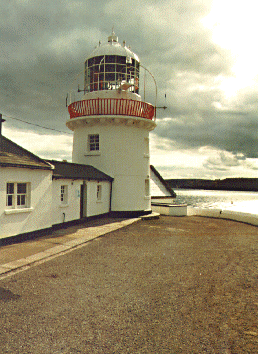 The photo above shows the STV Asgard II passing Roche's Point. The site was established in 1817 at the entrance to Cork Harbor, with a smal tower that was taken down and rebuilt at Duncannon, Waterford Harbour.
The photo above shows the STV Asgard II passing Roche's Point. The site was established in 1817 at the entrance to Cork Harbor, with a smal tower that was taken down and rebuilt at Duncannon, Waterford Harbour.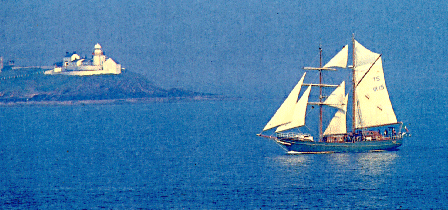 The present 15 meter tower was built in 1835, and is a familiar site to Swansea-Cork ferry passengers and Cobh and Crosshaven yachtsmen. Roche's Point Light stands 30 meters above the sea. from lighthousegetaway.com
The present 15 meter tower was built in 1835, and is a familiar site to Swansea-Cork ferry passengers and Cobh and Crosshaven yachtsmen. Roche's Point Light stands 30 meters above the sea. from lighthousegetaway.com
20090616
Lighthouse Keeper
Lighthouses and waves during VERY stormy weather
by Jean-René Keruzaoré
FARO º
20090615
Emine - Lighthouse
In the Middle Ages, there was a fortress called Emona on Cape Emine. Its name was derived from Aemon, the ancient name for Stara Planina. Nowadays, only some ruins of the fortress are left. There are also remnants of a monastery and a lighthouse. The village of Emona is located nearby.
20090612
"Old photo revisited"

"This shot, is one of my faves, I have processed it several times, as it actually was, in Mono, and now this version. it's the Lightnouse at New Brighton in the UK. It is one of those old fashioned seaside towns, that does excellent chips, and candy floss, while you do battle with the sea gulls to keep your food. The main attraction for me was the Lighthouse though, and the long promenade. Also. watching the kids trying to catch things like crabs.
Really like the the vintage feel to the image, old postcard feel.
Love Suzi x"
New Brighton Lighthouse was originally known as Perch Rock Lighthouse, and construction began in 1827. Since 1 October 1973 it has not been in use as a lighthouse, having been superseded by modern navigational technology.
20090608
CAPO L'AGULHAS
20090602
To the lighthouse
Come up to my lighthouse for I have something I wish to say
It can wait for a moment; well in fact
it can wait all day
I just wanted to bring you up here so you could have the chance to see
the beauty of this situation that
you could share with me
It may seem strange
to talk of love and then lighthouses
It's not strange
to me
Hey
All alone
you and I in our high tower
That's the way
to be
Some laugh at my lighthouse they say it's just an ivory tower
But I don't mind because I know
their envy grows by the hour
See I have a purpose up here to guide the ships upon their way
All this is mine; it could be yours too
what do you say?
My Lighthouse - Pulp





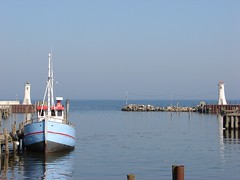






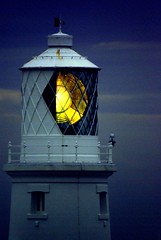




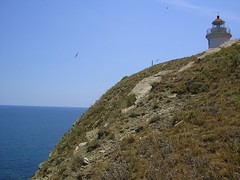




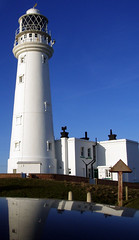
































































































.jpg)






























































































































